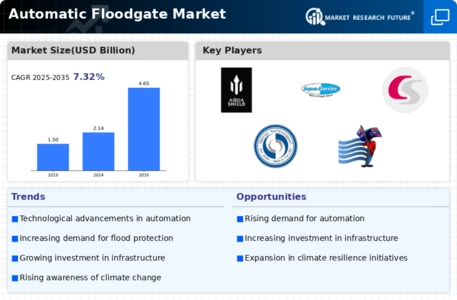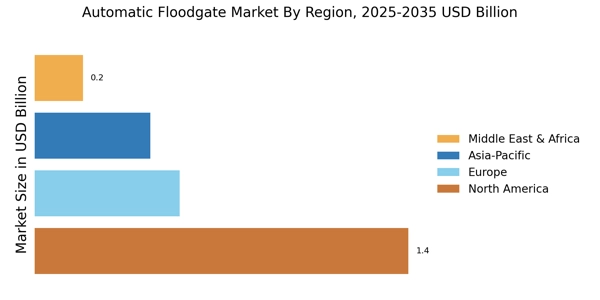Rising Urbanization
The trend of increasing urbanization appears to be a significant driver for the Automatic Floodgate Market. As more people migrate to urban areas, the risk of flooding in these densely populated regions escalates. Urban infrastructure often struggles to manage stormwater effectively, leading to a heightened demand for advanced flood management solutions. The Automatic Floodgate Market is likely to benefit from this trend, as municipalities seek to implement automated systems that can respond quickly to flooding events. According to recent estimates, urban areas are projected to house over 68% of the world's population by 2050, which could further amplify the need for effective flood control measures.
Climate Change Impacts
The ongoing effects of climate change are increasingly influencing the Automatic Floodgate Market. Rising sea levels and more frequent extreme weather events, such as heavy rainfall and storms, necessitate the adoption of innovative flood management technologies. The Automatic Floodgate Market is positioned to address these challenges by providing solutions that can adapt to changing environmental conditions. Research indicates that the frequency of severe flooding events has increased by approximately 20% over the last few decades, underscoring the urgency for municipalities and governments to invest in automated floodgate systems to protect infrastructure and communities.
Technological Innovations
Technological advancements are driving transformation within the Automatic Floodgate Market. Innovations such as IoT integration, real-time monitoring systems, and automated control mechanisms are enhancing the efficiency and effectiveness of floodgate operations. These technologies allow for timely responses to changing water levels and weather conditions, thereby reducing the risk of flooding. The market for smart flood management solutions is expected to grow significantly, with projections indicating a compound annual growth rate of over 15% in the coming years. This trend suggests that the Automatic Floodgate Market is on the cusp of a technological revolution that could redefine flood management practices.
Government Initiatives and Funding
Government initiatives aimed at enhancing flood resilience are playing a crucial role in the Automatic Floodgate Market. Various countries are implementing policies and allocating funding to support the development and installation of flood management systems. These initiatives often include grants, subsidies, and public-private partnerships that encourage investment in automated floodgate technologies. For instance, recent reports suggest that funding for flood management projects has increased by over 30% in several regions, reflecting a growing recognition of the need for proactive measures to mitigate flood risks. This financial support is likely to stimulate growth within the Automatic Floodgate Market.
Increased Investment in Infrastructure
The growing emphasis on infrastructure development is emerging as a key driver for the Automatic Floodgate Market. As nations prioritize the modernization of their infrastructure to withstand natural disasters, investments in flood management systems are becoming more prevalent. This trend is particularly evident in regions prone to flooding, where governments and private entities are recognizing the importance of resilient infrastructure. Recent data indicates that infrastructure spending is expected to rise by approximately 10% annually, with a significant portion allocated to flood control measures. This influx of investment is likely to bolster the Automatic Floodgate Market, facilitating the adoption of advanced floodgate technologies.


















Leave a Comment